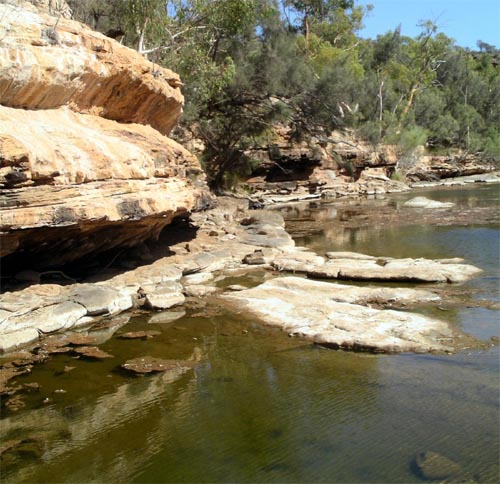Steindachner's Snake-necked Turtle -- Chelodina steindachneri
[5]

Natural habitat
The climate of Western Australia is Mediterranean in
the south and subtropical to tropical in the north. Chelodina steindachneri
lives in the Pilbara and Gascoyne regions which both have a hot dry climate
with at times intense rains associated with summer cyclones. The species
inhabits permanent water bodies in the west but also seasonal water bodies
further inland that may dry up for a year or two and possibly even longer.
Majority of rivers is largely intermittent and for the greater part of the
year has dry, sandy river beds with occasional permanent pools. When the
seasonal pools in the arid areas dry up, the turtle will either bury itself
in the river bed or bank or migrate to another water course. (Cann, 1998)
Right photo: Murchison River, W.A.
The waterways of this region generally have well-defined courses and are fresh, in contrast with the ill-defined drainages of the desert lands. They characteristically flow through extensive floodplains in their lower reaches, whereas their headwaters often flow through rocky gorges. At their ocean outlet some waterways disperse into broad salt marsh areas before merging with tidal inlets. (Department of Environment, 2004) These rivers are almost pristine. They provide habitat for birds, amphibiants, reptiles, native fish and macroinvertebrates. There are a wide range of waterway forms, including red sandstone gorges such as Yardie Creek and the Murchison River, broad valleys such as the Wooramel, Gascoyne, Lyons, Minilya, Lyndon and Ashburton rivers and meandering coastal plain waterways such as the Irwin and Moore rivers. (Department of Environment, 2004)
The pHs of the rivers in the Pilbara drainage division of Western Australia is always alkaline and ranges between 7.1 and 10.2 while the water temperature ranges between 10.8 to 40.4°C. (Morgan et al., 2004) Chelodina steindachneri most likely inhabits water with the temperature ranging from 18 to 30°C.
Rainfall is low through the entire area with a fairly uniform 200 - 250 mm throughout the entire distribution range. Some coastal areas can get up to 400 mm of annual rainfall. Drought is a major climate feature and often several almost rainless years will end with a cyclonic rain depression that brings floods. Summer (November - April) temperatures are hot well up in the forties while the winter (May - October) daylight highs are mild to warm ranging between 20 and 30°C. Cooler periods occur after strong cold fronts that may reach this far north.
Bottom photo: Climate: mean max/min temperature and precipitation
 Diet
Diet
No data are available concerning the species' diet. Cann (1998) kept some specimens overnight in a drum of water and noted their faeces contained the remains of small animals matter and what appeared to be algae.
I am inclined to believe this Chelodina species is carnivorous
like other species of the Chelodina genus. There are plenty of
fish in the rivers of the Pilbara Drainage Division including the following
families: Anguillidae (Anguilla spp.), Clupeidae
(Nematalosa spp.), Ariidae (Arius spp.), Plotosidae
(Neosilurus spp.), Melanotaeniidae (Melanotaenia
spp.), Atherinidae (Craterocephalus spp.), Terapontidae
(Amniataba and Leiopotherapon spp.), Eleotridae
(Hypseleotris spp.), Gobiidae (Glossogobius spp.).
(Morgan et al., 2004) Some of these could be possible eaten by
C. steindachneri either as a live-caught prey or carrion.
Breeding
Little breeding data is available for this species. Most of the research was done by Dr Gerald Kuchling. According to him, males become sexually mature at about 120 mm of carapace length and female are ready to reproduce at about 146 mm carapace length. Only one clutch a year is laid by females and egg size ranges from 27.5 to 31.0 mm in length and from 17.0 to 19.5 mm in width. (Kuchling, 1988) Eggs are laid in early spring (southern hemisphere time) from September to October and hatch in February (Burbidge, 1967) when the rain season starts. This would mean the incubation period is 140-180 days. Cann (1998) also proposes there is no nesting occurring before September as he collected seven mature females in late winter (27th August) and none of them contained any palpable eggs.
